| Bogleech Presents The Top Twenty Coolest Beetles |
| #20 - Dynastes - The "Hercules" Beetles |
I thought I might start with a relatively simple and already fairly popular family, Dynastes, also called
"Hercules," "rhinoceros" or even "unicorn" beetles. This group includes some of the longest and strongest of
all Coleoptera, thanks to the unique horns of the adult males. A single long horn curves out from the head
and another from the insect's thorax, forming a remarkable crab-like claw with the animal's entire head as the
lower joint. This weird arrangement is used primarily to grab and flip other males, who compete with one
another for a limited number of females. What other animal uses its forehead and its back as tongs?
Breeding these insects for tournament fighting is a major hobby in some countries, particularly Japan, and
was a partial inspiration for the Pokemon franchise.
"Hercules," "rhinoceros" or even "unicorn" beetles. This group includes some of the longest and strongest of
all Coleoptera, thanks to the unique horns of the adult males. A single long horn curves out from the head
and another from the insect's thorax, forming a remarkable crab-like claw with the animal's entire head as the
lower joint. This weird arrangement is used primarily to grab and flip other males, who compete with one
another for a limited number of females. What other animal uses its forehead and its back as tongs?
Breeding these insects for tournament fighting is a major hobby in some countries, particularly Japan, and
was a partial inspiration for the Pokemon franchise.
| #19 - Psephenidae - the "Water Penny" Beetles |
Adults of this unusual family are fairly mundane-looking little beetles, but lay their eggs in water where they
hatch into a completely unique type of larvae. With an armored back that flares out into a flattened sucker,
these tiny "water pennies" cling limpet-like to smooth rocks under powerful currents, even waterfalls and
white-water rapids where other creatures (including potential enemies) would be dashed to pieces. Their legs
are specially adapted for scraping algae or other detritus into their tiny mouths, and they may even prey
upon other small enough organisms in their wake.
hatch into a completely unique type of larvae. With an armored back that flares out into a flattened sucker,
these tiny "water pennies" cling limpet-like to smooth rocks under powerful currents, even waterfalls and
white-water rapids where other creatures (including potential enemies) would be dashed to pieces. Their legs
are specially adapted for scraping algae or other detritus into their tiny mouths, and they may even prey
upon other small enough organisms in their wake.
| #18 - Trachelophorus - the Giraffe Weevils |
Often distinguished by a long anteater-like snout, the Curculionoidea or "weevils" are actually the largest
beetle subgroup of all and one of the most common "superfamilies" in the animal kingdom. Though most of
them are already fairly comical looking as far as beetles go, the two known species in the genus
Trachelophorus are even sillier. The male alone possesses a greatly elongated head and thorax forming a
stiff, awkward "arm" with a single joint, which he uses during courtship and nest building; by tightly rolling a
leaf around his head, he creates a protective tube in which the female will lay a single egg. The longer his
neck, the more attractive he is to the females.
Do weevils suffer neck envy?
beetle subgroup of all and one of the most common "superfamilies" in the animal kingdom. Though most of
them are already fairly comical looking as far as beetles go, the two known species in the genus
Trachelophorus are even sillier. The male alone possesses a greatly elongated head and thorax forming a
stiff, awkward "arm" with a single joint, which he uses during courtship and nest building; by tightly rolling a
leaf around his head, he creates a protective tube in which the female will lay a single egg. The longer his
neck, the more attractive he is to the females.
Do weevils suffer neck envy?
| #17 - Rhipiceridae - the Cicada Parasite Beetles |
When young cicadas (another type of bug, not a beetle) hatch, they begin a long journey from the upper
branches of their tree to deep beneath the ground, where they attach to subterranean roots and will feed in
place for many years - sometimes up to seventeen - before they emerge en masse to molt into winged
adults, mate, lay eggs and die over the course of a few months. It is during this time that Rhipicerid beetles
begin their own brief mating frenzy:
branches of their tree to deep beneath the ground, where they attach to subterranean roots and will feed in
place for many years - sometimes up to seventeen - before they emerge en masse to molt into winged
adults, mate, lay eggs and die over the course of a few months. It is during this time that Rhipicerid beetles
begin their own brief mating frenzy:
| A cicada molting into an adult - photo by Anita Gould |
| #16 - Stenus - the jaw-throwing Rove Beetles |
| #14 - Xyleborus - Ambrosia Beetles |
These incredibly tiny, snoutless members of the Weevil family are a rare example of a fully social beetle and
one half of a sophisticated symbiotic partnership. The adult beetles typically excavate tunnels or "galleries" in
dead or dying wood, not to feed upon the wood directly, but to cultivate wood-digesting ambrosia fungus,
which constitutes their entire diet and extracts all the nutrients they need from the surrounding tree. Both
beetle and fungus are entirely dependent upon one another for existence, with special pouches on the
insect's body adapted to collect and transport fungal spores to new trees.
One species of ambrosia beetle, Austroplatypus incompertus, is the very first beetle to ever be recognized as
eusocial, meaning that it forms colonies of specialized castes like those of ants, bees and termites, including
both reproductive and non-reproductive roles.
one half of a sophisticated symbiotic partnership. The adult beetles typically excavate tunnels or "galleries" in
dead or dying wood, not to feed upon the wood directly, but to cultivate wood-digesting ambrosia fungus,
which constitutes their entire diet and extracts all the nutrients they need from the surrounding tree. Both
beetle and fungus are entirely dependent upon one another for existence, with special pouches on the
insect's body adapted to collect and transport fungal spores to new trees.
One species of ambrosia beetle, Austroplatypus incompertus, is the very first beetle to ever be recognized as
eusocial, meaning that it forms colonies of specialized castes like those of ants, bees and termites, including
both reproductive and non-reproductive roles.
| #13 - Platypsyllus - Beaver Beetles |
Eyeless, wingless and smaller than a pinhead, these beetles closely resemble fleas because they, too, live in
the fur of mammals - specifically beavers. Unlike fleas, however, these "beaver bugs" are harmless and
perhaps even hygenic to their hosts, feeding only upon dead flakes of skin, mites and other contaminants in
beaver fur. Few other beetles are so heavily adapted to the body of another animal, and thus far, these
seldom-seen weirdos have been found living on virtually no other type of mammal.
the fur of mammals - specifically beavers. Unlike fleas, however, these "beaver bugs" are harmless and
perhaps even hygenic to their hosts, feeding only upon dead flakes of skin, mites and other contaminants in
beaver fur. Few other beetles are so heavily adapted to the body of another animal, and thus far, these
seldom-seen weirdos have been found living on virtually no other type of mammal.
| #12 - Gyrinidae - the Whirligig Beetles |
Many beetles are known for their amphibious habits, but the Gyrinidae are adapted unlike any other insect to
a life half-submerged at the water's surface, suspended perfectly by surface tension where they buzz about
like miniature motorboats. A whirligig beetle's four paddle-like rear legs beat up to sixty times a second to
propel it at high speeds, while the foremost pair of limbs are adapted into a set of gripping claws, used to
prey upon insects that fall into the water. Highly unusual are the beetle's eyes; a single huge pair run all the
way through the head to protrude out both the top and bottom, giving the appearance of four separate eyes
while giving the insect an equally detailed view of the sky above and water below.
a life half-submerged at the water's surface, suspended perfectly by surface tension where they buzz about
like miniature motorboats. A whirligig beetle's four paddle-like rear legs beat up to sixty times a second to
propel it at high speeds, while the foremost pair of limbs are adapted into a set of gripping claws, used to
prey upon insects that fall into the water. Highly unusual are the beetle's eyes; a single huge pair run all the
way through the head to protrude out both the top and bottom, giving the appearance of four separate eyes
while giving the insect an equally detailed view of the sky above and water below.
| Written by Jonathan Wojcik |

| Photo by Sparks68 - taken at the Oxford Natural History Museum |
The order Coleoptera (sheath-winged) or "beetles" are not only the largest order of the class Insecta, but the
largest order of animal life by a staggering margin. Nearly half of all known insects are some variety of beetle,
constituting roughly a quarter of all life as we know it - and hundreds of new beetles are discovered every
year. To put this in perspective, there are more named species of weevil alone than every fish, amphibian,
reptile, bird and mammal on our planet put together, and weevils are just one of the many families and
superfamilies comprising the Coleoptera. So what exactly defines a beetle?
largest order of animal life by a staggering margin. Nearly half of all known insects are some variety of beetle,
constituting roughly a quarter of all life as we know it - and hundreds of new beetles are discovered every
year. To put this in perspective, there are more named species of weevil alone than every fish, amphibian,
reptile, bird and mammal on our planet put together, and weevils are just one of the many families and
superfamilies comprising the Coleoptera. So what exactly defines a beetle?
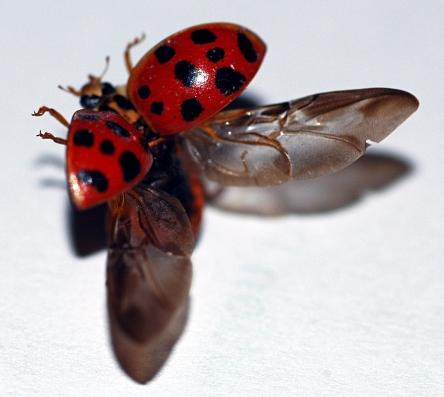
Though we're about to talk about some pretty deviant forms, most beetles are simple to identify by the
presence of elytra. Actually a pair of hardened wings, the elytra form a tight shell against the beetle's
abdomen and can usually flip open to unfurl the rear set of flight wings. While this setup makes their flight
fairly awkward, it also offers excellent protection from predators and has no doubt contributed to the
Coleoptera's success.
presence of elytra. Actually a pair of hardened wings, the elytra form a tight shell against the beetle's
abdomen and can usually flip open to unfurl the rear set of flight wings. While this setup makes their flight
fairly awkward, it also offers excellent protection from predators and has no doubt contributed to the
Coleoptera's success.
| Photo by Charles & Clint |
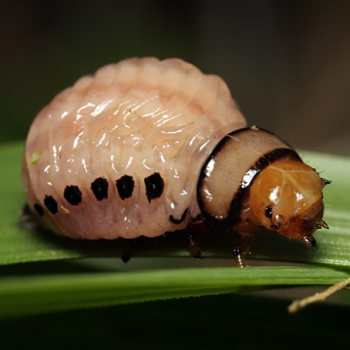
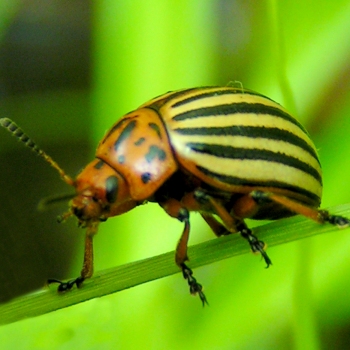
Beetles are also among the insect groups to always undergo "complete metamorphosis," meaning that they
hatch from eggs as worm-like larvae or "grubs" and pass through a normally immobile pupal stage before
becoming adults. As with many insects, the larval stage often represents the majority of the animal's lifespan,
while the "adult" is little more than a short-lived reproductive stage. Now, I'm sure your next question is
undoubtedly "are beetles bugs?" which is a slightly less stupid question than many of you probably think.
hatch from eggs as worm-like larvae or "grubs" and pass through a normally immobile pupal stage before
becoming adults. As with many insects, the larval stage often represents the majority of the animal's lifespan,
while the "adult" is little more than a short-lived reproductive stage. Now, I'm sure your next question is
undoubtedly "are beetles bugs?" which is a slightly less stupid question than many of you probably think.
| Photos By Myriorama - Potato Beetle Larva and Adult |
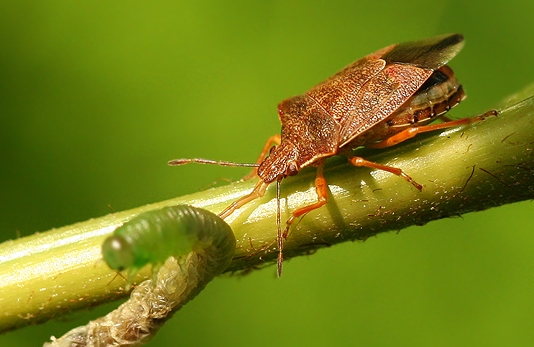
Here, we see a predatory stink bug impale prey on its straw-like feeding tube. Bugs are not beetles, but
members of the order Hemiptera, the second largest group of insects. Though they look superficially similar
to beetles at first glance, bugs are only distantly related and do not pass through a larval stage, never
possess elytra (notice the flat wings simply folded over one another) and always possess a fused, straw-like
sucking mouth. Beetles never possess this type of mouth, but usually chew their food with mandibles, the
more popular of the insect mouth-parts.
Of course, nature likes to throw curveballs now and then, so there are some beetles that look more like ants
or wasps than beetles or bugs. Many beetles are flightless, and may not have elytra or wings at all. Some
beetles don't even leave the larval stage. Whether you're a life-long entomologist or barely know your
silverfish from your firebrats, I hope you'll find something interesting in my stupid little countdown list of the
weirdest, coolest, prettiest and most extreme Coleoptera on Earth...
members of the order Hemiptera, the second largest group of insects. Though they look superficially similar
to beetles at first glance, bugs are only distantly related and do not pass through a larval stage, never
possess elytra (notice the flat wings simply folded over one another) and always possess a fused, straw-like
sucking mouth. Beetles never possess this type of mouth, but usually chew their food with mandibles, the
more popular of the insect mouth-parts.
Of course, nature likes to throw curveballs now and then, so there are some beetles that look more like ants
or wasps than beetles or bugs. Many beetles are flightless, and may not have elytra or wings at all. Some
beetles don't even leave the larval stage. Whether you're a life-long entomologist or barely know your
silverfish from your firebrats, I hope you'll find something interesting in my stupid little countdown list of the
weirdest, coolest, prettiest and most extreme Coleoptera on Earth...
| Photo By Lynette |
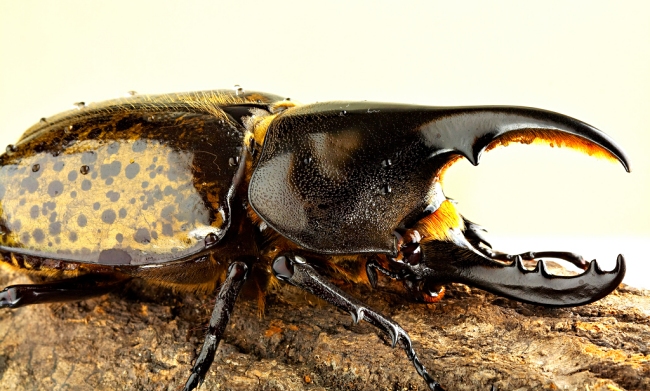


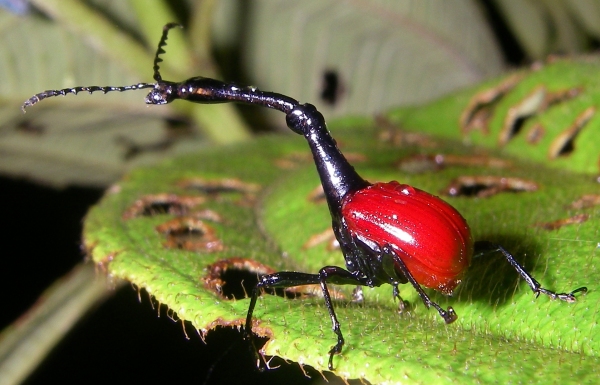

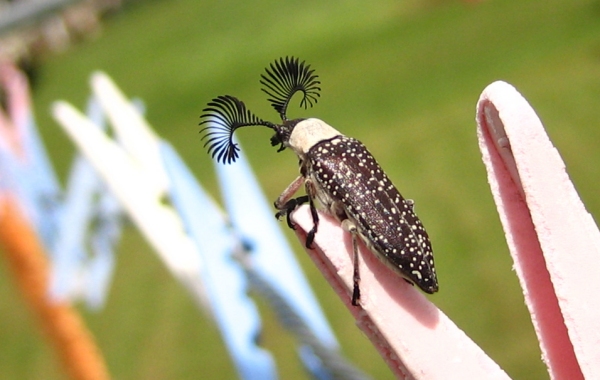
Employing their beautiful feelers to sinister ends, these beetles sniff out trees laden with Cicada eggs and lay
their own eggs in vast numbers, which hatch some time after the new generation of cicadas. The almost
invisibly tiny beetle larvae drop to the ground and wind their way through soil, hunting for cicada nymphs to
attach to. The immature beetles will live their lives as a parasite's parasite, growing large, fat and sedentary
off the blood of a nymph that in turns feeds from the same tree root for most of its life.
their own eggs in vast numbers, which hatch some time after the new generation of cicadas. The almost
invisibly tiny beetle larvae drop to the ground and wind their way through soil, hunting for cicada nymphs to
attach to. The immature beetles will live their lives as a parasite's parasite, growing large, fat and sedentary
off the blood of a nymph that in turns feeds from the same tree root for most of its life.
| #15 - Scarabaeinae - the Dung Beetles |
Revered in ancient Egypt, the Scarabaeinae are famous for their habit of rolling animal droppings into
spheres. This is primarily performed by the male, whose dung-ball is both an advertisement of his manhood
and a future nursery for his offspring. The female may assist in rolling the ball far away from competitors or
simply ride along while her mate does all the work. Picking out a prime spot, they load up the dung-ball with
eggs and sometimes bury themselves with it to watch over the larvae.
As competition for Mother Nature's special brownies can naturally get pretty fierce, some species don't even
wait for it to hit the ground; they'll happily camp out for hours to get pieces of crap straight from the source,
much like otaku.
spheres. This is primarily performed by the male, whose dung-ball is both an advertisement of his manhood
and a future nursery for his offspring. The female may assist in rolling the ball far away from competitors or
simply ride along while her mate does all the work. Picking out a prime spot, they load up the dung-ball with
eggs and sometimes bury themselves with it to watch over the larvae.
As competition for Mother Nature's special brownies can naturally get pretty fierce, some species don't even
wait for it to hit the ground; they'll happily camp out for hours to get pieces of crap straight from the source,
much like otaku.
Another, possibly weirder dung beetle is Zonocopris gibbicollis, which lives only on the bodies of giant African
snails to feed on the host's feces. Please thank - and visit! - Kabinet of Curiosities for drawing my
attention to this.
snails to feed on the host's feces. Please thank - and visit! - Kabinet of Curiosities for drawing my
attention to this.


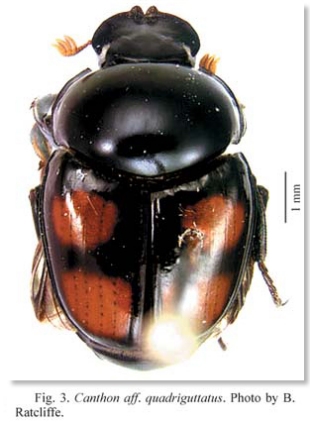
| Photo Credit: Jacobs et al. 2008. Neotropical Entomology 37(6):641-5. |
Yes, some species just cling tenaciously to the buttocks of large mammals such as this titi monkey, waiting for
the next steamy bus ride to the forest floor. When their host begins defecating, the beetles simply hop
aboard the droppings and hang on for dear life, guaranteeing themselves first dibs on one of insectkind's
hottest commodities.
the next steamy bus ride to the forest floor. When their host begins defecating, the beetles simply hop
aboard the droppings and hang on for dear life, guaranteeing themselves first dibs on one of insectkind's
hottest commodities.
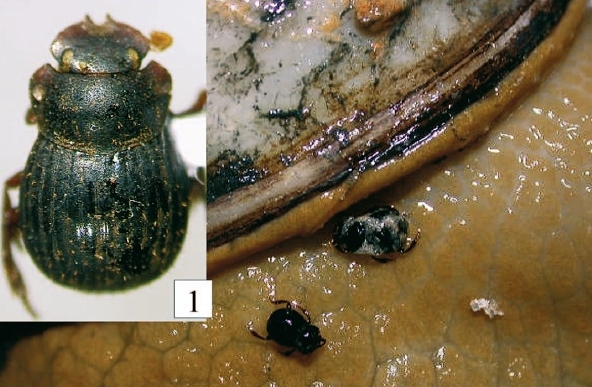

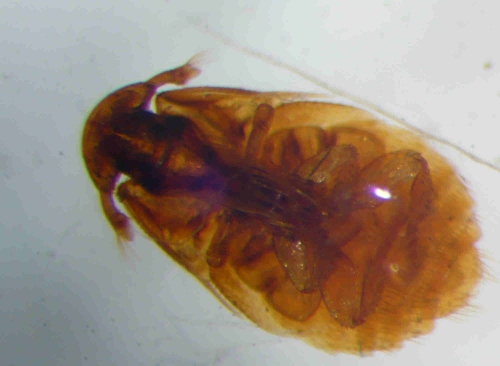
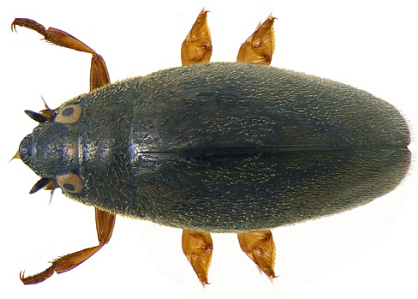
Gyrinidae have a natural drive to gather in large numbers that appear at first glance to exist in total chaos,
with dozens of individuals zipping and whirling about one another at incredibly high speeds. Like cells in a
brain, the insects are actually communicating non-stop to maintain perfect order, with a specific placement in
the group for each individual.
with dozens of individuals zipping and whirling about one another at incredibly high speeds. Like cells in a
brain, the insects are actually communicating non-stop to maintain perfect order, with a specific placement in
the group for each individual.
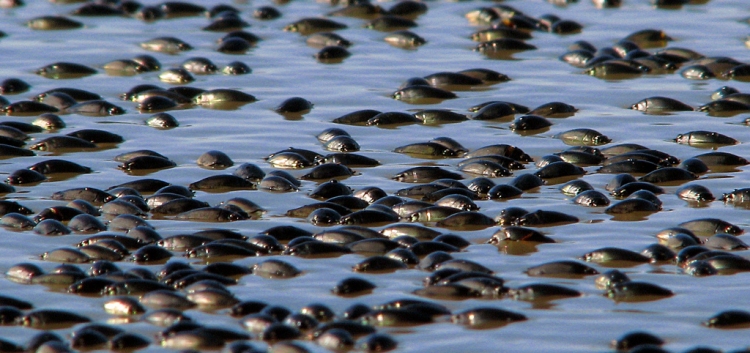
| #11 - Brachinidae - the Bombardier Beetles |
| Photo from the BBC |
Combined together, the volatile ingredients reach nearly boiling temperatures and build pressure until they
"flash evaporate," exploding from a specialized opening near the anus in a burst of searing hot, vile smelling
and vile tasting vapor. The entire process - from frightened beetle to killer gas attack - is so instantaneous
that it can repeat several hundred times in a fraction of a second, appearing as a single blast to the human
eye, and its highly flexible abdomen allows it to aim the explosion in almost any direction.
"flash evaporate," exploding from a specialized opening near the anus in a burst of searing hot, vile smelling
and vile tasting vapor. The entire process - from frightened beetle to killer gas attack - is so instantaneous
that it can repeat several hundred times in a fraction of a second, appearing as a single blast to the human
eye, and its highly flexible abdomen allows it to aim the explosion in almost any direction.
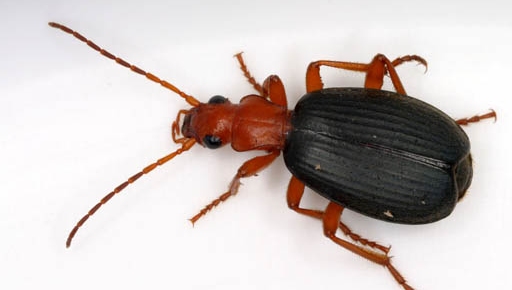
These carabids don't look that unusual or dangerous on the outside, but that mistake has probably left
mental scars on millions of insect-eaters. Housed within the abdomen of a brachinus beetle are two separate
chemical compounds; hydrogen peroxide and hydroquinone. When it feels threatened enough, the insect
empties the two chemicals into a "mixing chamber" of water and special catalytic enzymes...
mental scars on millions of insect-eaters. Housed within the abdomen of a brachinus beetle are two separate
chemical compounds; hydrogen peroxide and hydroquinone. When it feels threatened enough, the insect
empties the two chemicals into a "mixing chamber" of water and special catalytic enzymes...
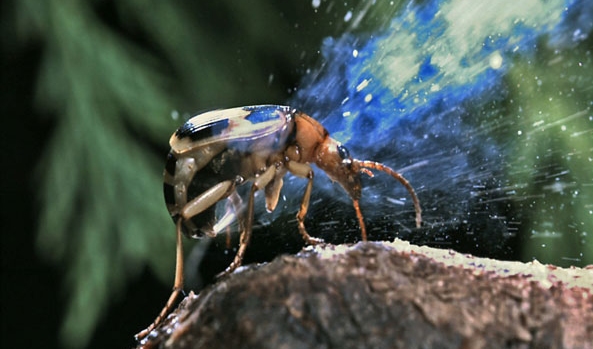
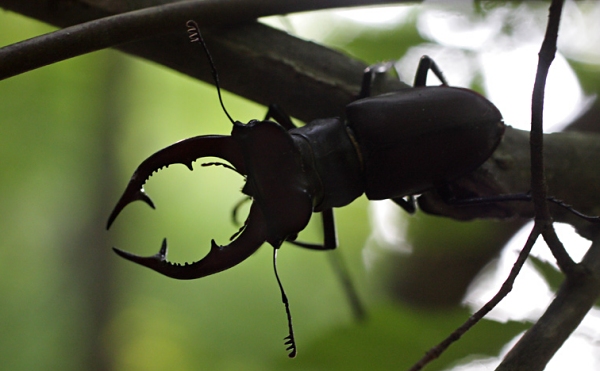
The closely related "stag" beetles (Lucanidae) are similar to the Dynastes, but males spar using mandibles
so huge that they are useless for eating. Both groups spend many years as grubs in soil or rotting wood,
living for only a few months as adults. HERE you can watch the amazing (and ultimately ridiculous) adventure
of one stag beetle (a Darwin's beetle) fight his way to romance and forget when to stop.
so huge that they are useless for eating. Both groups spend many years as grubs in soil or rotting wood,
living for only a few months as adults. HERE you can watch the amazing (and ultimately ridiculous) adventure
of one stag beetle (a Darwin's beetle) fight his way to romance and forget when to stop.
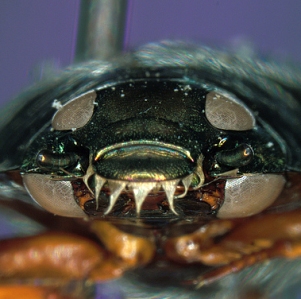

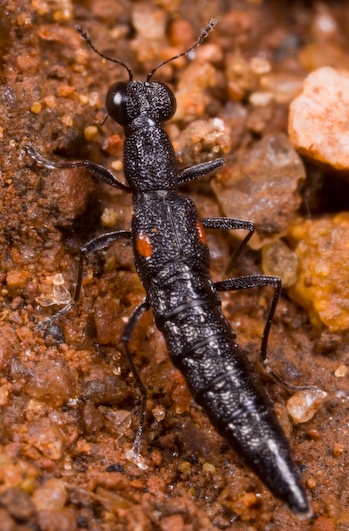
The "rove beetles" or Staphylinids are the second largest beetle family after the weevils, though they
scarcely resemble beetles at all. Their wings, when they have wings, are folded under extremely short elytra
leaving most of their tapering, flexible bodies uncovered. Most of them are extremely tiny, carnivorous and
adapted to highly specific diets. The Stenus genus prey upon extremely tiny arthropods such as mites or
springtails, and have adapted an unusual means of capturing their meals. Their labium (often described as
an insect's "lower lip") can be "launched" by blood pressure on a long, thin stem like the tongue of a
chameleon, tipped with various barbs and even an adhesive secretion to reel in helpless creatures.
scarcely resemble beetles at all. Their wings, when they have wings, are folded under extremely short elytra
leaving most of their tapering, flexible bodies uncovered. Most of them are extremely tiny, carnivorous and
adapted to highly specific diets. The Stenus genus prey upon extremely tiny arthropods such as mites or
springtails, and have adapted an unusual means of capturing their meals. Their labium (often described as
an insect's "lower lip") can be "launched" by blood pressure on a long, thin stem like the tongue of a
chameleon, tipped with various barbs and even an adhesive secretion to reel in helpless creatures.